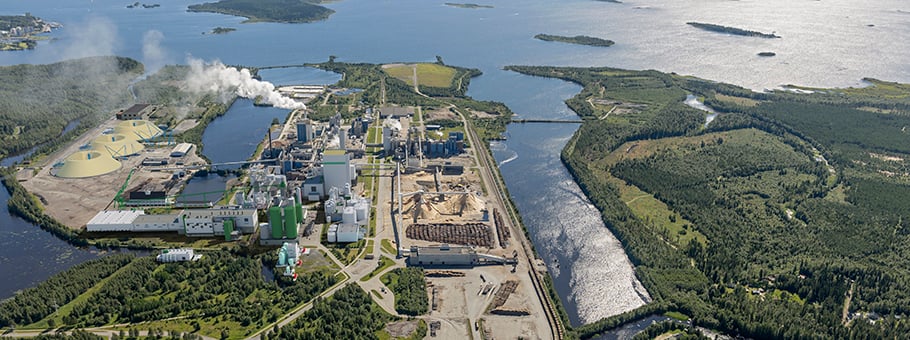
Metsä Group's strategic objectives include increasing the value of the Finnish forests, profitable growth together with its customers, reducing the use of fossil fuels, increasing the volume of renewable energy production, and increasing carbon sequestration in wood products with a long life span.
Metsä Group continues to implement its strategy with project planning for the construction of a new bio-product plant in Kemi and a new pine sawmill in Rauma, and the first phase of the regeneration of Husum pulp mill in Sweden. If these planned investments are realised, their total value would be around EUR 2 billion during 2019 to 2023. It is estimated that the investments in Kemi and Rauma would generate a positive annual income effect of around EUR 0.6 billion in Finland, a EUR 0.7 billion increase in exports, and a positive impact on employment worth around 2,000 person-years In direct value chains at the plants. The employment impact of the construction phases of the new plants in Kemi and Rauma would be around 11,500 person-years.
Metsä Fibre, part of Metsä Group, has completed the preliminary evaluation commenced in May 2018 on the further development of the pulp mill in Kemi. The preliminary evaluation examined the construction of a completely new, much larger bio-product plant or, alternatively, the extension of the life cycle of the existing pulp mill by modernising its departments. The preliminary evaluation focused on the availability of wood raw material and the development potential of Kemi's industrial infrastructure and logistics connections.
Based on the preliminary evaluation, a decision was made to start preparing the construction of a new bio-product plant in Kemi. The purpose of this project planning is to create the facilities for building a plant with the annual production capacity of around 1.5 million tonnes of softwood and hardwood pulp, as well as various other bio-products in the current location of the Metsä Group plant site in Kemi. If implemented, it would be the largest wood-processing plant in the northern hemisphere. The new plant would replace the current pulp mill in Kemi with the annual production capacity of around 620,000 tonnes. The value of the investment would be around EUR 1.5 billion.
The annual pulpwood consumption of the new bio-product plant in Kemi would be around 7.6 million cubic metres, roughly 4.5 million more than that of the current plant. The aim is to source the pulpwood mainly from Finland. Securing the wood sourcing for the mill requires further studies on the potential in the supply area to maximise the share of domestic wood.
The Kemi bio-product plant would employ around 250 people directly, and a total of around 2,500 people in the entire direct value chain. This would mean an increase of some 1,500 people, compared to the current situation. In the construction phase of the plant, the impact on employment is estimated to be almost 10,000 person-years, with more than half of this in Kemi. The design premise is a fossil-free plant and 250% self-sufficiency in electricity. The pulp production volumes would be sold mainly to European and Asian customers, as well as to the Metsä Board linerboard plant that is part of the Metsä Group and located on the same factory site. The actual investment decision on the construction of the plant is expected to be made no earlier than summer 2020.
Metsä Fibre is also launching project planning for the construction of a pine sawmill on the plant site in Rauma. The estimated annual production of the sawmill would be around 750,000 cubic metres, and the plan is to make it the world’s most modern and efficient unit in its field. New technology and the utilisation of data will be taken to new levels, compared to the existing sawmill units. The value of the investment would be around EUR 200 billion. It would employ around 100 people directly, and around 500 people in the entire direct value chain. In the construction phase of the plant, the impact on employment is estimated to be around 1,500 person-years. The sawmill’s annual sawlog consumption would be around 1.5
million cubic metres. The wood would be sourced mainly from Finland. The new sawn timber volumes would mainly be sold to European and Asian customers. The actual investment decision on the construction of the sawmill is expected to be made in early 2020.
Metsä Board has carried out a preliminary evaluation on the modernisation of the integrated board and pulp mill in Husum, Sweden and is launching the first phase of project planning. The aim is to build a new soda recovery boiler and turbine to replace the existing ones. The total investment carried out during 2019–2022 would be around EUR 300 million. During the second phase, in the 2020s, the plan is to replace the two existing fibre lines in the mill with one new. Following the investments, the plant's annual pulp capacity of around 750,000 tonnes would remain unchanged, but its cost competitiveness would be improved significantly. At the earliest, the actual investment decision on the first phase of the possible modernisation of the Husum pulp mill will be assessed in the last quarter of 2019.
The planned investments will implement Metsä Group's strategic objectives by reducing the use of fossil fuels by more than 400 GWh per year, by increasing the volume of renewable electricity production by more than 2 TWh per year, and by increasing carbon dioxide sequestration in wood products with a long life span by around 700,000 tonnes per year.
Factors that affect the final investment decisions include securing wood sourcing, preconditions for trouble-free transport, development of the global economy, in particular Asian economies, the results of EIA processes, environmental permits, the situation on the financial market and export financing, as well as cooperation with various parties in the areas of wood sourcing, logistics, planning and licensing.
"Metsä Group's mission is to add value to trees grown responsibly in Finland. Forest owners' goal is to produce high-quality saw-logs and we ensure sufficient competitive processing capacity for our mechanical forest industry, producing wood products that sequestrate carbon in the long term. Before the logging phase, forests need to be thinned to make room for growth. We also need competitive processing capacity for this wood from thinning and for the wood from regeneration harvesting that is unsuitable for mechanical processing. This wood can be used to produce a wide range of fibre products to substitute fossil materials on the world market. With these planned investments, we will ensure that, with regard to the value chain of the entire forest industry, we can be more efficient in meeting the needs of forest owners and customers, and play a significant role in mitigating climate change," says Ilkka Hämäläinen, CEO of Metsä Group.

